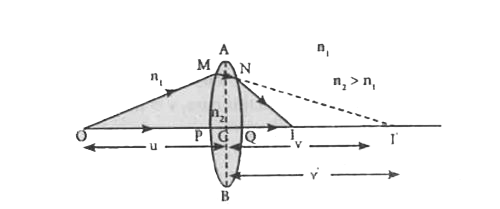Derive th lens maker's formula.Solution in Kannada

Consider a thin convex lens placed in a medium of refractive index n1. Let n2 be the refractive index of the material of the lens.
Let O be the a point luminous object placed on the principle axis at a distance u from its optic centre as shown in fig. A ray OP incident along the principle axis proceeds undeviated. Another paraxial ray incident on the lens along OM is refracted along MN and emerges along NI. The emergent ray meet at I on the principle axis.I is the real image of object O.
The formation of image I can be considered in two stages.
1. Refraction at surface APB: In the absence of the second surface AQB, the refracted rays MN and PQ intersect at I1 in the medium of refractive index n1. I1 is real image of object O formed due to refraction at the surface APB. For this refraction from rarer to denser medium. Object distance =OP=u. Image distance =PI1=v1
∴n2v.=n1u=n2−n1R1 ....(1)
Refraction at a surface AQB: Rays MN and PQ incident on the surface AQB undergo refraction and emerge out of the lens. The emergent rays intersect at I on the principal axis I1 acts as virtual object for the refraction at AQB and its real image is I. The refraction is from denser to rarer medium. For the refraction
Object distance = QI1=v1
Image distance =QI=v.
i.e., n1v−n2v.=−(n2−n2R2) ...(2)
Adding equations (1) and (2)
n1v−n1u=n2−n1R1−n2−n1R2=(n2−n1){1R1−1R2}
Dividing throughout by n1
1v−1u=n2−n1n1{1R1−1R2}=(n2n1−1){1R1−1R2}
i.e., 1v−1u=(n21−1){1R1−1R2} where n21=n2n1
If u=∞ then the incident beam on the lens is a parallel beam. The final image will be formed at the principal focus . In this case, v=f.
∴1f=(n21−1){1R1−1R2}
This relation is known as lens maker.s formula. If the refractive index of the material of the lens is n and it is placed in air then
1f=(n−1){1R1−1R2}
Topper's Solved these Questions
- SUPPLEMENTARY EXAM QUESTION PAPER JULY -2015BOOK - SUNSTAR PUBLICATIONCHAPTER - SUPPLEMENTARY EXAM QUESTION PAPER JULY -2015EXERCISE - PART-D
11 Videos
- SUPPLEMENTARY EXAM QUESTION PAPER JULY - 2014BOOK - SUNSTAR PUBLICATIONCHAPTER - SUPPLEMENTARY EXAM QUESTION PAPER JULY - 2014EXERCISE - PART-D (VI. Answer any three of the following questions.)
5 Videos
- SUPPLEMENTARY EXAM QUESTION PAPER JUNE-2019BOOK - SUNSTAR PUBLICATIONCHAPTER - SUPPLEMENTARY EXAM QUESTION PAPER JUNE-2019EXERCISE - Part-C
18 Videos
Similar Questions
Derive an expression for the electric field at a point due to an infinitely long thin charged straight wire using Gauss Law.
View SolutionTwo charges 3x10−8C & −2x10−8C are located 15 cm apart. At what point on the line joining the two charges is the electric potential zero? Take the potential infinity to be 0.
View SolutionMention and five properties of electric field lines.
View SolutionDerive lens maker's formula for a thin convex lens.
View SolutionWrite the lens maker's formula.
View SolutionDerive th lens maker's formula.
View SolutionDerive th lens maker's formula.
View SolutionDerive th lens maker's formula.
View SolutionDerive th lens maker's formula.
View SolutionLens maker's formula is applicable to
View SolutionObtain lens maker's formula and medium its signification. Lens maker's formula and lens equation:
View SolutionLens formula is
View SolutionDerive lens maker's formula for a thin biconvex lens.
View SolutionUsing lens maker's formula, derive the thin less formula 1/f=1/v-1/u for a biconevex lens.
View SolutionDerive th lens maker's formula.
View SolutionDerive lens maker's formula for a biconvex lens.
View Solution
